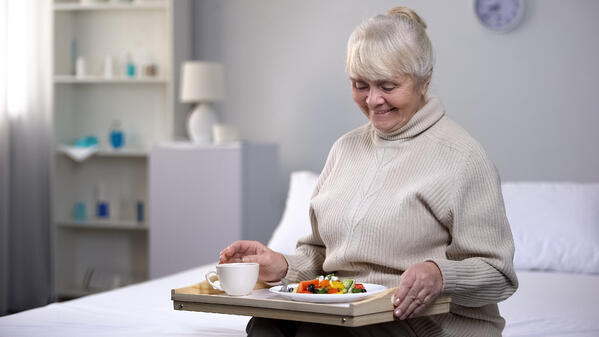
Senior Living: Shifting to In-Room Dining
Senior living dining rooms have a reputation for providing restaurant-quality experiences. The restaurant manager, wait staff and chefs are all focused on maintaining a strong sense of community through the meals they serve. The dining room itself promotes enhanced social interaction between the residents and encourages them to view the staff as an extension of their own family.

The meals are fresh, nutritious and enjoyable. Just as important is the presentation. Going the extra mile and paying attention to every detail demonstrates a higher level of care. But what happens when the dining room is no longer an available destination for the residents to meet, socialize and enjoy their meals? What happens when, in a time of crisis, the administrators of the senior living community are forced to close that space?
The In-Room Experience
When difficult decisions need to be made for the health and safety of the entire senior living community, residents are often encouraged to stay within their own apartments. Instead of having breakfast, lunch and dinner together as a group – socializing with their friends and neighbors – the residents are asked to take necessary precautions and enjoy their meals in the comfort of their own rooms.
In-house delivery systems that utilize insulated trays, domes and bases, allow the kitchen to continue serving a variety of meals on dining room dinnerware. Hot foods are kept hot and cold foods are kept cold, and the carts are wheeled directly into the residents’ rooms, similar to how room service is typically managed. Although the setting and atmosphere may have changed, the experience is closer to remaining the same. However, being able to accommodate at this level of service may not be a viable option for every community.
Thankfully, senior living communities are widely known for being extremely creative when it comes to taking care of their residents. They are quick to act and able to recognize, early on, any adjustments to service that are required. As such, in times of need, the decision to begin exclusively using disposables and to-go containers as an immediate answer to the in-room dining and delivery equation is what many senior living communities have chosen.
Disposables and to-go containers provide a much-needed solution. Their designs are flexible, easy to manage, efficient to use and are a reliable option when it comes to ensuring that the senior community continues to receive hot, healthy and delicious meals.
Transforming the Dining Room
Dining rooms – typically open for the residents to enjoy their meals and socialize with their friends and neighbors – can be quickly transformed into areas for high numbers of meal preparation and staging. The kitchen and wait staff can use these spaces to prepare the meals for in-room deliveries; making sure that hot food is kept hot and cold food is kept cold; and loading them onto the trays and carts for in-room delivery.
Consolidating the deliveries for each wing of a senior living complex ensures that the quality of food remains high. Organizing the space and making the process more efficient translates into greater opportunity to deliver these essential meals quickly and productively.
And while storage is often a concern for senior living communities, in times of crisis, intelligent and creative decisions need to be made. Transitioning almost entirely to disposables as their primary dinnerware inevitably results in larger product counts. Acknowledging this increased demand, the kitchen and wait staff have the option to convert unused dining rooms into newly available storage spaces.
More Than Just a Meal
Many of the residents in a senior living community visit their dining room two or three times each day. This is a space that not only ensures they're receiving the proper nourishment, but also provides much needed social interaction. When the residents are asked to stay in their rooms, interactions with caregivers becomes essential to their continued mental health and well-being.

Creativity (again) is key to keeping the residents happy and engaged. To accommodate for this need, some communities are thinking outside the box and bringing special treats to the residents’ rooms. Adapting a meal cart to “dish out” old-fashioned ice cream sundaes, door-to-door, is a great way to lift spirits. Utilizing hydration carts to offer a variety of beverages, snacks, yogurt, cheese and fruit also ensures the seniors are maintaining a healthy diet.
Spending this extra, unscheduled time with the residents, providing greater interaction with the caregivers and keeping things lighthearted promotes greater mental health and helps to fill those social interaction gaps. Because everyone involved in the senior living community understands that, at its foundation, it will always be about taking care of the people.
Want more help from a Boelter expert adjusting your senior living operation to these uncertain times? Get in touch with us so we can help find solutions fit for your facility.